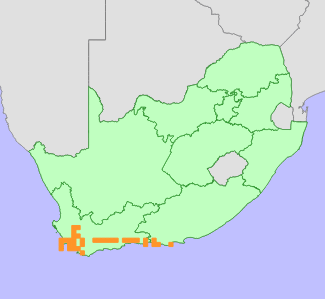|
Scientific Name | Disa bivalvata (L.f.) T.Durand & Schinz |
Higher Classification | Monocotyledons |
Family | ORCHIDACEAE |
Synonyms | Disa melaleuca (Thunb.) Sw., Ophrys bivalvata L.f., Orthopenthea bivalvata (L.f.) Rolfe, Penthea melaleuca (Thunb.) Lindl., Serapias melaleuca Thunb. |
National Status |
Status and Criteria | Least Concern |
Assessment Date | 2020/02/18 |
Assessor(s) | L. von Staden |
Justification | Disa bivalvata is a widespread species, with an extent of occurrence (EOO) of 49 221 km². It is declining in parts of its range due to ongoing habitat loss and degradation, but is not yet in danger of extinction. It is listed as Least Concern. |
Distribution |
Endemism | South African endemic |
Provincial distribution | Eastern Cape, Western Cape |
Range | This species is endemic to South Africa, and occurs from the Cape Peninsula in the Western Cape to Humansdorp in the Eastern Cape. |
Habitat and Ecology |
Major system | Terrestrial |
Major habitats | Peninsula Sandstone Fynbos, South Langeberg Sandstone Fynbos, Kogelberg Sandstone Fynbos, Hawequas Sandstone Fynbos, Hangklip Sand Fynbos, South Outeniqua Sandstone Fynbos, North Langeberg Sandstone Fynbos, Overberg Sandstone Fynbos, Winterhoek Sandstone Fynbos, Tsitsikamma Sandstone Fynbos, North Outeniqua Sandstone Fynbos, South Sonderend Sandstone Fynbos, North Sonderend Sandstone Fynbos, Cape Flats Sand Fynbos |
Description | It occurs on sandstone slopes and seeps. |
Threats |
| Disa bivalvata is threatened by habitat loss to urban expansion and coastal development along the southern Cape coast. Many subpopulations are also threatened by competition from alien invasive plants. |
Population |
This is a widespread and common species, often forming large colonies. It flowers most profusely in recently burnt fynbos. The population trend is not known, but it is suspected to be declining.
|
Population trend | Decreasing |
Assessment History |
Taxon assessed |
Status and Criteria |
Citation/Red List version | | Disa bivalvata (L.f.) T.Durand & Schinz | Least Concern | Raimondo et al. (2009) | |
Bibliography |
Goldblatt, P. and Manning, J.C. 2000. Cape Plants: A conspectus of the Cape Flora of South Africa. Strelitzia 9. National Botanical Institute, Cape Town.
Johnson, S. and Bytebier, B. 2015. Orchids of South Africa: A field guide. Struik Nature, Cape Town.
Linder, H.P. 1999. Disa. In: H.P. Linder and H. Kurzweil (eds.), Orchids of southern Africa (pp. 187-288), A.A. Balkema, Rotterdam.
Manning, J.C. and Goldblatt, P. 2012. Plants of the Greater Cape Floristic Region 1: The Core Cape Flora. Strelitzia 29. South African National Biodiversity Institute, Pretoria.
Raimondo, D., von Staden, L., Foden, W., Victor, J.E., Helme, N.A., Turner, R.C., Kamundi, D.A. and Manyama, P.A. 2009. Red List of South African Plants. Strelitzia 25. South African National Biodiversity Institute, Pretoria.
Vlok, J. and Schutte-Vlok, A.L. 2010. Plants of the Klein Karoo. Umdaus Press, Hatfield.
|
Citation |
| von Staden, L. 2020. Disa bivalvata (L.f.) T.Durand & Schinz. National Assessment: Red List of South African Plants version 2024.1. Accessed on 2025/12/13 |
 Comment on this assessment
Comment on this assessment


